Languedoc-Roussillon
The Languedoc-Roussillon is divided into the departments Aude, Gard, Hérault, Lozère and Pyrénées-Orientales. This area of France is still largely unspoilt and awaits discovery. It is, however, one of the jewels of France with its uinique culture, natural splendour and history. On top of that, the many hours of sunshine, the wine and delicious food and the Occitan hospitality makes it a perfect holiday destination.
Nature is breathtaking. You can go white water rafting, canooing, walking, mountain biking, mountain hiking, horse riding, enjoy the many wonderful views and visit the many natural areas. It is also a great place to get some peace and rest. Take a boat trip along the Canal du Midi or discover Cathar Country on horseback.
The natural splendour is merely a backdrop to its many historical sites and towns. With its impressive history and historical treasures which are spread out throughout the land, the Languedoc-Roussillon is a culture paradise for the interested traveller. Visit for instance the largest medieval town in Europe, Carcassonne. An absolute "must".
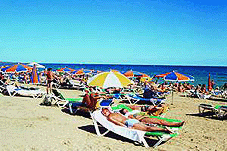 Also the coast line has a bit of Spanish charm, with its palm trees and Catalan tonque, it's mediterranean dishes and beautiful beaches. The coast line of the Languedoc-Roussillon has the most hours of sunshine of France. Seaside towns such as Argelès-sur-Mèr, Canet-Plage and Collioure are fantastic places to stay or visit, where you can enjoy sun, sea and sand. It is also a good base to explore the inland sites such as some of the Cathar Castles or abbeys in the Pyrenees.
Also the coast line has a bit of Spanish charm, with its palm trees and Catalan tonque, it's mediterranean dishes and beautiful beaches. The coast line of the Languedoc-Roussillon has the most hours of sunshine of France. Seaside towns such as Argelès-sur-Mèr, Canet-Plage and Collioure are fantastic places to stay or visit, where you can enjoy sun, sea and sand. It is also a good base to explore the inland sites such as some of the Cathar Castles or abbeys in the Pyrenees.
Come and explore the Land of Oc, where the Knights Templar wanted to create a state of their own, where the Cathars lived and worked, and where many legends have their historical roots. Climb one of the Cathar Castles, enjoy a sorbet in one of the old towns or on the beach, discover the Enigma of Rennes-le-Chateau or go for a lovely walk through the National Park de Haute Languedoc. All is possible here, in just 1 vacation.
THE NORTH
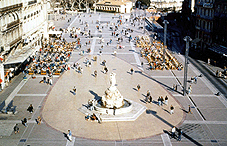 Montpellier
Montpellier
Montpellier is the capital of the Herault department and of the Languedoc-Roussillon. It is a regional metropolitan which started its existance in the Middle Ages, when two smaller towns melted together to form one large town. In 1196, a wall was built to protect the town. You can still find several buildings of this period in the city centre, such as the Tour de la Babote and the Tour des Pins. In the early 13th century, the city of Montpellier belonged to the Spanish realm of Aragon. It had autonomy under the rule of a consul. In 1349, the city was sold to the French empire. During the Wars of Religion, all churches were distroyed. After the end of the Wars, Montpellier became the capital of the Languedoc. In the 17th and 18th centuries, the town saw the construction of many new buildings. Squares were built and beautiful houses for the rich inhabitants. Also the wine trade became an important source of income from the 19th century onwards. When Montpellier became the capital of the Languedoc Roussillon, after this province had been divided into 22 regions, the city became very prestigeous.
The sites of Montpellier are for the larger part in the old, medieval centre. The highest point is the Promenade Royale du Peyrou, on the west side of the old centre. Here you find the 18th century water tower, a statue of Louis XIV on horseback and the Arch du triomphe du Montpellier sits on the spot where the old city wall used to be.
The Cathedral of St. Pierre was, after the destructions during the Religious Wars, rebuilt in Gothic style in the 17th century. Also interesting is the very first open staircase that was built in the Languedoc, in Hotel de Mirman. It is a Gothic house from the 13th century, but when it was rebuilt in the 17th century, the open staircase was added, setting a fashion in the area. A little bit further on you find the old Jewish bath house de Mikwe, which is about 800 years old.
Art lovers will enjoy a visit to the Musée Fabre, where you can admire many wonderful paintings. But when you want to shop, you have to go to the Place de la Comédie. This is a large pedestrial area which flows northwards into the modern mall of Le Polygone.
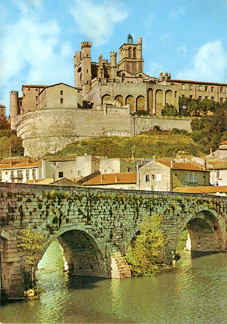 Béziers
Béziers
In Roman times, Béziers was on the Via Domitia, which went from Rome to Spain. Therefore, it was an important Roman city. In the Middle Ages, Béziers was a trade centre. In 1209, it was the most important city of the Viscounts of Trencavel. Carcassonne was another important town, owned by this noble family. In this year, Béziers was besieged by the armies of the king of France and the Pope, who were hungry for possession of the southern lands and eager to get rid of the anti-catholic Cathar Christians. Although Béziers wasn't exactly a city full of Cathars, they were made an example of. On 22nd July, on Mary Magdalene's name day, thousands of people were brutally murdered when the city fell. When someone asked how to recognise a Cathar from a Catholic person, they were told: "Kill them all, God will recognise his own". This blood bath was quite a shock wave going through the entire realm of Oc. It shook its foundations. This was the beginning of a battle known as the Occitan Cause, the feudal Lords of Occitania against the northern armies of France. It was also a battle between Cathars and Catholics, which would last for centuries and would even be felt in the northern countries of Belgium and the Netherlands where heretics were burned at the stake many centuries later. Everybody who was not Catholic, had to be forced into Catholicism (all means were used, torture was common) or killed. And not just Cathars, also Jews. When Béziers fell, the city was annexed by the French kingdom. Later, when Protestants protested once more against Catholicism, the city again took quite a beating. But finally, Béziers climbed out of its mysery and especially after the creation of the Canal du Midi, profited from the wine trade. The canal made sure that all wines could be transported quickly.
Today, Béziers is visited by many tourists. Interesting sites are the sluices of Fonséranes. Seven sluices overcome a difference in height of 21,50 meters. The centre of town lies on a rock, on which the cathedral dominates the city. The promenade Allées Paul Riquet, named after the inventor and builder of the Canal du Midi, has kept its 19th century charm. The cathedral itself is dedicated to St. Nazaire, and after its destruction in 1209 it was rebuilt between the 13th and 15th centuries. From the cathedral you have a wonderful view over the city and the valley of the Orb river.
From the D19 you can drive towards the coast, where you can cool off from the Summer's heat in the small seaside resort of Valras Plage. But also the valley of the Orb offers refreshment. In the mountains (National Park de Haute Languedoc) you can explore lovely old villages.
Agde
The area around Agde was colonised by Cretans, Egyptians and Phoenicians. Around 500 B.C.E., Greek colonists from Phocea founded the city of Agathè Tychè (prosperity). Agde lies on an old vulcano and many buildings have been constructed with basalt stone. There are still some Greek remains to be found. In the 5th century, Agde became the seat of a bisshop. In the 9th century, the cathedral of St. Etienne was built. Interesting sites are the musée Agathois with a collection of fine paintings, costumes, art, archaeology and earthenware from the area, the Chateau Laurens (art Nouveau) and the subterranean icestorage from the 17th century near the city wall. The doors, which date from the 16th to the 18th century, are quite special.
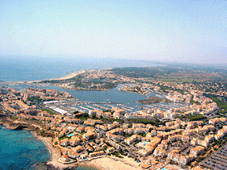 Cap d'Agde was hardly inhabited until the sixties of the 20th century. It was merely a cape into the Mediterranean Sea. However, in the seventies, when the beaches near the cape were discovered, the first buildings were constructed. Today, Cap d'Agde has one of the largest number of rooms in the entire Languedoc. Apart from the many places to hang out such as bars, restaurants, discos etc. it also has several tourist attractions. First of all the Musée de l'Ephèbe, where you can see a large bronze statue from the 4th century. The theme of the museum is underwater achaeology. In the Sea Aquarium you van see many beautiful fish and other sea animals. In the natural reserve on the Pic Saint-Loup you can visit the Tour des Anglais, which was built in the 17th century to keep an eye on the English and the pirates who were a threat to these parts. The mountain in the centre of the reserve is the old vulcano, which has erupted for the last time approx. 750.000 years ago.
Cap d'Agde was hardly inhabited until the sixties of the 20th century. It was merely a cape into the Mediterranean Sea. However, in the seventies, when the beaches near the cape were discovered, the first buildings were constructed. Today, Cap d'Agde has one of the largest number of rooms in the entire Languedoc. Apart from the many places to hang out such as bars, restaurants, discos etc. it also has several tourist attractions. First of all the Musée de l'Ephèbe, where you can see a large bronze statue from the 4th century. The theme of the museum is underwater achaeology. In the Sea Aquarium you van see many beautiful fish and other sea animals. In the natural reserve on the Pic Saint-Loup you can visit the Tour des Anglais, which was built in the 17th century to keep an eye on the English and the pirates who were a threat to these parts. The mountain in the centre of the reserve is the old vulcano, which has erupted for the last time approx. 750.000 years ago.
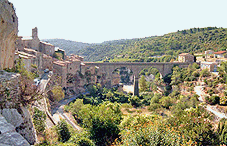 Minerve
Minerve
Minerve is situated on a rock and the moment you have parked your car on the car park on the other side of the bridge, you will notice that this is a very special walled town. It used to be impregnable, but it was still taken in 1210 during the Wars against the Cathars. Cathar hunter Simon de Montfort made his camp around the town of Minerve and after 5 weeks de Montfort succeeded in destroying the well by means of large catapults, of which a copy can still be seen. The inhabitants were almost dying of thirst when they surrendered. Approx. 180 Cathars died in the flames of a large pyre. Next to the church of st. Etienne (11th/12th century), you can see a monument to these martyrs, a rock with a dove cut out.
In spite of the bloody history, the town has a lovely tranquil atmosphere, coffee terraces overlook the beautiful surroundings. Minerve is, however, much older than the 12th century. The name betrayes its origin. The ancient cult of Sulis-Minerva was introduced here by the Greeks and Romans, but even millions of years ago there was life here. The remains of dinosaurs found in the area are to be seen in the small but beautiful museum, which is well worth a visit! Apart from pre-historic remains you also see a nice collection of other archaeological finds from the pre-history until the Roman and Visigoth period.
A bit further back you will arrive at La Candela, the remains of a tower which was part of the original castle of Minerve. The castle was dismantled in 1636 by orders of Louis XIII. The tower itself dates from the middle of the 13th century and cannot be visited. From Minerve you can explore the breathtaking area in and around the gorge.
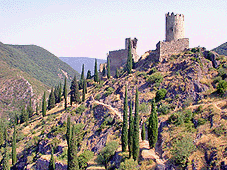 Lastours
Lastours
Lastours is the name of 4 castles: Cabaret, Tour Régine, Fleur d'Espine and Quertinheux. In the 12th century, these castles formed the stronghold Cabaret. Pierre Roger de Cabaret, lord of the castle, fought to protect the cathars in the early 13th century. In 1210, Simon de Montfort was unable to take Cabaret. This attracted many Cathars from the area, who flocked together around the castles of Lastours and felt safe. In 1211 however, Pierre Roger de Cabaret had to surrender to Simon de Montfort. The Cathars who were able to flee, almost all went to Montségur. Others travelled to Quéribus or fled deep into the Montagne Noire, where impenetrable forests protected them. According to many legends, the Cathars were in the possession of a treasure, secret knowledge and/or holy relics, which they are said to have hidden somewhere in the Languedoc.
THE SOUTH
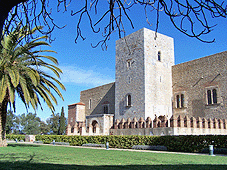 Perpignan
Perpignan
Perpignan is a friendly town with many small streets. Several beautiful buildings are silent witnesses of economic prosperity in the old days. The Palace of the Kings of Majorca was built between the 13th and 14th century and is the oldest royal residence in France. It was built after Jacques le Conquérant (James the Conqueror) decided to make Perpignan capital of the kingdom of Majorca. The Citadel is still in good condition and offers great views over the city.
Perpignan has several interesting churches, such as the Notre Dame Ste Marie la Réal, a typical example of southern Gothic architecture. The Church of St. Jacques dates from the 14th century and was built on the old city wall. The cathedral, St. Jean Baptiste, is also worth a visit.
In the centre of Perpignan we find the beautiful medieval Place de la Loge with its magnificent old buildings, like the old city hall and the old courthouse from the 14th century. At the Place de Verdun you find Le Castillet from the 14th century. This was the location from where the city was defended. In Le Castillet you will now find the interesting local museum. Around this building, on 23rd June each year, you can admire fireworks in celebration of the festival of St. Jean Baptiste.
At the Place Armand Lanoux you find the tourist office. There are regular markets and in Summer you can visit the flee market, which is held every Sunday morning near the Palais des Expositions.
Just outside Perpignan there are several beautiful beaches. Best seaside towns: Argelès-sur-Mèr, Canet-Plage and the beautiful ancient fishing village of Collioure.
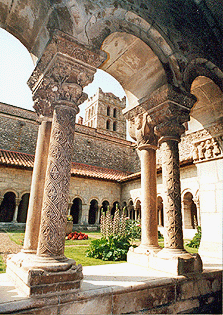 Ancient Elne, a bit more inland, has a long history. When the Romans came, they did not really find it so important. They named it Illiberis. In the 4th century the cital was rebuilt by emperor Constantine the Great, and renamed the town Helena, after his mother, who, according to legend, was murdered here. It immediately became the capital of the Roussillon. Half way through the 5th century, Elne became the seat of a bisshop. More than a thousand years later, in 1602, this seat moved to Perpignan.
Ancient Elne, a bit more inland, has a long history. When the Romans came, they did not really find it so important. They named it Illiberis. In the 4th century the cital was rebuilt by emperor Constantine the Great, and renamed the town Helena, after his mother, who, according to legend, was murdered here. It immediately became the capital of the Roussillon. Half way through the 5th century, Elne became the seat of a bisshop. More than a thousand years later, in 1602, this seat moved to Perpignan.
The cathedral st. St. Eulalie is worth a visit, several parts are from the 11th century. But the most famous attraction is the monastery with its magnificent pillars, not one of them is the same. In the monastery you can visit a small but beautiful archaeological museum. In the village you can take a stroll through the medieval centre. From the walls you have a beautiful view towards the holy mountain, Canigou.
When you love natural beauty, then the Vallée de la Têt is definitely worth a visit. The Têt is a small river which winds its way towards the Mediterranean via Perpignan. The river has its well on the mountain Pic Carlit near Font Romeu and on its journey towards the sea, it has created a wonderful valley. Near Ille-sur-Têt you can visit the organ pipes, eroded rock formations. The area is breathtaking!
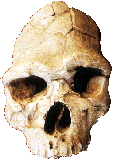 In Tautavel you can visit the prehistoric museum, named after the Homme de Tautavel, who lived here over 450.000 years ago in the dry areas in caves and holes. The museum is impressive. Apart from the remains of Tautavel man, many finds can be seen from the area. In the village are several restaurants.
In Tautavel you can visit the prehistoric museum, named after the Homme de Tautavel, who lived here over 450.000 years ago in the dry areas in caves and holes. The museum is impressive. Apart from the remains of Tautavel man, many finds can be seen from the area. In the village are several restaurants.
In the Corbière you can find mountainous areas like the Montagne d'Alaric and the foothills of the Pyrenees. Here you will find ancient ruins and medieval fortresses. A legend tells of the Visigoth king Alaric II, who was burried with his treasures in a cave underneath his castle, Miramont.
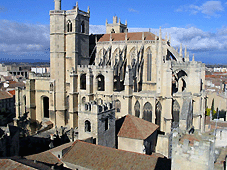 Narbonne has been inhabited since ancient times. The Romans turned it into a flourishing port. From Roman times there are little remains. Largely because the ancient buildings were later used as quarries for medieval buildings. However, there are a few farms which are still standing on Roman found-ations. These used to be Roman villas and you can still see the villa like shape when you look close. Today, Narbonne is a coy shopping town with a beautiful cathedral (do not forget to take a look at the cloisters) and several medieval buildings.
Narbonne has been inhabited since ancient times. The Romans turned it into a flourishing port. From Roman times there are little remains. Largely because the ancient buildings were later used as quarries for medieval buildings. However, there are a few farms which are still standing on Roman found-ations. These used to be Roman villas and you can still see the villa like shape when you look close. Today, Narbonne is a coy shopping town with a beautiful cathedral (do not forget to take a look at the cloisters) and several medieval buildings.
About 15 km south of Narbonne lies Sigean, known for its wonderful safari park 'Réserve Africaine de Sigean'. It welcomes visitors the whole year round from as early as 9.00 hours. The park provides a comfortable habitat for lions, elephants, South African Springbok, chimpanzees, flamingos, ostriches, giraffes, pelicans, rhinos, black bears and many other wild animals. You can drive through the park with your car. There is a restaurant and an information desk. A wonderful day out!
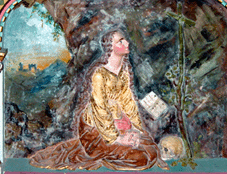 Rennes-le-Château
Rennes-le-Château
This place is more than just a village on another hill. It was originally part of an old fortified city called Rhedae, which, alongside Carcassonne, was an important city in ancient times. It also played a role in the legends of the Holy Grail and the Arc of the Covenant, as well as in the stories around the lost kings of the Visigoths and Merovingians. Templar gold was hidden in several of the many caves of the area. In the village church and the Magdala tower, new discoveries have been made. People from all over the world study the enigma of Rennes-le-Chateau. The area is dotted with ancient remains of Celtic and Roman times. The interesting church of La Madeleine at Rennes-le-Chateau reveals symbolism from forgotten times, double meanings, secret abbreviations... buying a booklet in the village bookshop is definitely worth the money. Discover the enigma of Rennes-le-Chateau and visit the museum about the mysterious life of Abbot Saunière. And finally, the view from the top of the Magdala Tower across the valley, where many historians, scientists and archaeologists are still pondering about today, is unforgettable. Especially when you can see the snow topped Pyrenees on a clear day.
You can have a nice refreshment in Le Jardin de Marie, near the ancient mysterious castle of Rennes, which is sometimes referred to as the temporary resting place of the Arc of the Covenant...
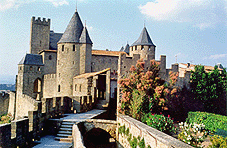 Carcassonne
Carcassonne
This city, which has two separate parts, is an absolute 'must' when you visit the Languedoc.
History
Before the Romans arrived, this particular site was already long inhabited. The Romans built their castellum in the 2nd century B.C. after which the first wall was erected around the fort. After the Romans, the Cité was a Visigoth stronghold. For a very short period it was even taken by the Moors. In this period, the best known legend of Carcassonne came into existence. The story of Madame Carcas, the wife of the Saraceen Balaak.
"When Charlemagne stood before the gates of Carcassonne with his troops, the castle army existed of only one person, Madame Carcas. She gave the illusion that many men were still on the walls. When Charlemagne wanted to starve the castle, and Dame Carcas heard of his plans, she threw a pig over the wall, filled with sweet corn. This made Charlemagne believe that there was still enough food left, so he packed up and left. On the site of his retrieve, she triumphantly blew her horn (Carcas sonne)."
Another story tells of the presence of sun temples or sun churches, which would have been responsible for the name Carcassonne (Karke Sonne). However, it is more likely that its name is based on the name of the Roman fortress, Carcasso. The connection with the sun temples and a possible Egyptian influence in its Celtic history is now a discussion between scholars.
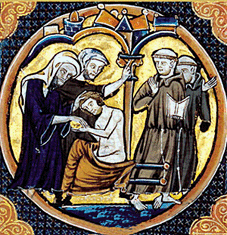 When Carcassonne was re-conquered from the Moors, it became the possession of several noble families, of which the Trencavel family was the last. In 1074, Lord Bernard Aton Trencavel was the Lord of Carcassonne and the Razés, Agde, Béziers, Albi and Nimes. In the 13th century, the city of Carcassonne had to surrender to the catholic army during the crusade against the Cathars. The 24-year old Count Raymond-Roger de Trencavel was taken prisoner and very badly treated, so that he died only a short time after. This news shocked the Languedoc. Trencavel offered a sanctuary to the Cathars and was therefore taking sides against the church of Rome.
In 1226, crusade leader Simon de Montfort gave Carcassonne to the French crown, after which a second wall was erected. The son of Raymond-Roger, also called Roger, tried to regain Carcassonne in 1240, but failed and fled to Barcelona. Louis IX, consequently, gave the order to destroy the houses around the castle, after which the inhabitants were driven out of the Cité. They weren't allowed to come back for at least 7 years. In 1248 they received permission to build the Ville Basse (Lower town) on the other side of the river Aude. In the middle of the 14th century, Froissart described Carcassonne as a flourishing town with about 7000 houses and famous for her textile industry. Unfortunately, this industry collapsed around the beginning of the 15th century. It wasn't until the 17th century that the city enjoyed another period of prosperity. In the years of the Revolution, Carcassonne didn't play a large part. However, the economic decay during the Revolution, as well as the Napoleonic Wars and the British Influence around the Mediterranean, ended this period of prosperity. In the late 19th century, Carcassonne renovated its historic buildings and tried to make profit from the wine industry. Today, much of its income and prosperity relies on the tourist industry.
When Carcassonne was re-conquered from the Moors, it became the possession of several noble families, of which the Trencavel family was the last. In 1074, Lord Bernard Aton Trencavel was the Lord of Carcassonne and the Razés, Agde, Béziers, Albi and Nimes. In the 13th century, the city of Carcassonne had to surrender to the catholic army during the crusade against the Cathars. The 24-year old Count Raymond-Roger de Trencavel was taken prisoner and very badly treated, so that he died only a short time after. This news shocked the Languedoc. Trencavel offered a sanctuary to the Cathars and was therefore taking sides against the church of Rome.
In 1226, crusade leader Simon de Montfort gave Carcassonne to the French crown, after which a second wall was erected. The son of Raymond-Roger, also called Roger, tried to regain Carcassonne in 1240, but failed and fled to Barcelona. Louis IX, consequently, gave the order to destroy the houses around the castle, after which the inhabitants were driven out of the Cité. They weren't allowed to come back for at least 7 years. In 1248 they received permission to build the Ville Basse (Lower town) on the other side of the river Aude. In the middle of the 14th century, Froissart described Carcassonne as a flourishing town with about 7000 houses and famous for her textile industry. Unfortunately, this industry collapsed around the beginning of the 15th century. It wasn't until the 17th century that the city enjoyed another period of prosperity. In the years of the Revolution, Carcassonne didn't play a large part. However, the economic decay during the Revolution, as well as the Napoleonic Wars and the British Influence around the Mediterranean, ended this period of prosperity. In the late 19th century, Carcassonne renovated its historic buildings and tried to make profit from the wine industry. Today, much of its income and prosperity relies on the tourist industry.
The Ville Basse
The lower town is a more modern place with several medieval remains. Interesting are the remains of the wall and gate near the main shopping street, the two churches of St.Vicent and St. Michel, and Place Carnot with the 18th century fountain of Neptune in the middle of the square. This square is the centre of the town, with its many terraces and shops.
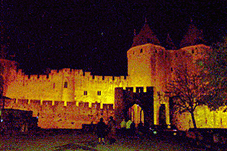 The Cité
The Cité
The oldest part is the Cité, the best kept medieval city in Europe. Here you can stroll around its medieval streets. The major attraction is the castle, which you can visit with a guide only. While waiting for the guide, you can take a look at the museum. The guide takes you from the main building over the walls to the other side. You cannot go back to the museum or the attached souvenir shop, so if you want to buy something or visit the museum, you can only do so before the guided tour. At the end of the tour you will see the old St. Nazaire church. This is a Roman/Gothic church with many legends of Templar treasure. Inside you will see among other things an image of the Holy Trinity, a statue of Anna and her daughter Mary, and in the chapel of the Notre Dame (13th century) you can see the Tree of Jesse. The most famous item is no doubt the Siege Stone, on which you can see the Siege of Carcassonne in 1209 by the crusaders.
It is interesting to take a walk in between the walls of the Cité, or do so by tourist train. In July and August there is a feast in the Cité almost every Saturday. Ask the tourist office for more information. The Cité is beautifully lit at night.
Nature is breathtaking. You can go white water rafting, canooing, walking, mountain biking, mountain hiking, horse riding, enjoy the many wonderful views and visit the many natural areas. It is also a great place to get some peace and rest. Take a boat trip along the Canal du Midi or discover Cathar Country on horseback.
The natural splendour is merely a backdrop to its many historical sites and towns. With its impressive history and historical treasures which are spread out throughout the land, the Languedoc-Roussillon is a culture paradise for the interested traveller. Visit for instance the largest medieval town in Europe, Carcassonne. An absolute "must".
 Also the coast line has a bit of Spanish charm, with its palm trees and Catalan tonque, it's mediterranean dishes and beautiful beaches. The coast line of the Languedoc-Roussillon has the most hours of sunshine of France. Seaside towns such as Argelès-sur-Mèr, Canet-Plage and Collioure are fantastic places to stay or visit, where you can enjoy sun, sea and sand. It is also a good base to explore the inland sites such as some of the Cathar Castles or abbeys in the Pyrenees.
Also the coast line has a bit of Spanish charm, with its palm trees and Catalan tonque, it's mediterranean dishes and beautiful beaches. The coast line of the Languedoc-Roussillon has the most hours of sunshine of France. Seaside towns such as Argelès-sur-Mèr, Canet-Plage and Collioure are fantastic places to stay or visit, where you can enjoy sun, sea and sand. It is also a good base to explore the inland sites such as some of the Cathar Castles or abbeys in the Pyrenees.Come and explore the Land of Oc, where the Knights Templar wanted to create a state of their own, where the Cathars lived and worked, and where many legends have their historical roots. Climb one of the Cathar Castles, enjoy a sorbet in one of the old towns or on the beach, discover the Enigma of Rennes-le-Chateau or go for a lovely walk through the National Park de Haute Languedoc. All is possible here, in just 1 vacation.
THE NORTH
 Montpellier
MontpellierMontpellier is the capital of the Herault department and of the Languedoc-Roussillon. It is a regional metropolitan which started its existance in the Middle Ages, when two smaller towns melted together to form one large town. In 1196, a wall was built to protect the town. You can still find several buildings of this period in the city centre, such as the Tour de la Babote and the Tour des Pins. In the early 13th century, the city of Montpellier belonged to the Spanish realm of Aragon. It had autonomy under the rule of a consul. In 1349, the city was sold to the French empire. During the Wars of Religion, all churches were distroyed. After the end of the Wars, Montpellier became the capital of the Languedoc. In the 17th and 18th centuries, the town saw the construction of many new buildings. Squares were built and beautiful houses for the rich inhabitants. Also the wine trade became an important source of income from the 19th century onwards. When Montpellier became the capital of the Languedoc Roussillon, after this province had been divided into 22 regions, the city became very prestigeous.
The sites of Montpellier are for the larger part in the old, medieval centre. The highest point is the Promenade Royale du Peyrou, on the west side of the old centre. Here you find the 18th century water tower, a statue of Louis XIV on horseback and the Arch du triomphe du Montpellier sits on the spot where the old city wall used to be.
The Cathedral of St. Pierre was, after the destructions during the Religious Wars, rebuilt in Gothic style in the 17th century. Also interesting is the very first open staircase that was built in the Languedoc, in Hotel de Mirman. It is a Gothic house from the 13th century, but when it was rebuilt in the 17th century, the open staircase was added, setting a fashion in the area. A little bit further on you find the old Jewish bath house de Mikwe, which is about 800 years old.
Art lovers will enjoy a visit to the Musée Fabre, where you can admire many wonderful paintings. But when you want to shop, you have to go to the Place de la Comédie. This is a large pedestrial area which flows northwards into the modern mall of Le Polygone.
 Béziers
BéziersIn Roman times, Béziers was on the Via Domitia, which went from Rome to Spain. Therefore, it was an important Roman city. In the Middle Ages, Béziers was a trade centre. In 1209, it was the most important city of the Viscounts of Trencavel. Carcassonne was another important town, owned by this noble family. In this year, Béziers was besieged by the armies of the king of France and the Pope, who were hungry for possession of the southern lands and eager to get rid of the anti-catholic Cathar Christians. Although Béziers wasn't exactly a city full of Cathars, they were made an example of. On 22nd July, on Mary Magdalene's name day, thousands of people were brutally murdered when the city fell. When someone asked how to recognise a Cathar from a Catholic person, they were told: "Kill them all, God will recognise his own". This blood bath was quite a shock wave going through the entire realm of Oc. It shook its foundations. This was the beginning of a battle known as the Occitan Cause, the feudal Lords of Occitania against the northern armies of France. It was also a battle between Cathars and Catholics, which would last for centuries and would even be felt in the northern countries of Belgium and the Netherlands where heretics were burned at the stake many centuries later. Everybody who was not Catholic, had to be forced into Catholicism (all means were used, torture was common) or killed. And not just Cathars, also Jews. When Béziers fell, the city was annexed by the French kingdom. Later, when Protestants protested once more against Catholicism, the city again took quite a beating. But finally, Béziers climbed out of its mysery and especially after the creation of the Canal du Midi, profited from the wine trade. The canal made sure that all wines could be transported quickly.
Today, Béziers is visited by many tourists. Interesting sites are the sluices of Fonséranes. Seven sluices overcome a difference in height of 21,50 meters. The centre of town lies on a rock, on which the cathedral dominates the city. The promenade Allées Paul Riquet, named after the inventor and builder of the Canal du Midi, has kept its 19th century charm. The cathedral itself is dedicated to St. Nazaire, and after its destruction in 1209 it was rebuilt between the 13th and 15th centuries. From the cathedral you have a wonderful view over the city and the valley of the Orb river.
From the D19 you can drive towards the coast, where you can cool off from the Summer's heat in the small seaside resort of Valras Plage. But also the valley of the Orb offers refreshment. In the mountains (National Park de Haute Languedoc) you can explore lovely old villages.
Agde
The area around Agde was colonised by Cretans, Egyptians and Phoenicians. Around 500 B.C.E., Greek colonists from Phocea founded the city of Agathè Tychè (prosperity). Agde lies on an old vulcano and many buildings have been constructed with basalt stone. There are still some Greek remains to be found. In the 5th century, Agde became the seat of a bisshop. In the 9th century, the cathedral of St. Etienne was built. Interesting sites are the musée Agathois with a collection of fine paintings, costumes, art, archaeology and earthenware from the area, the Chateau Laurens (art Nouveau) and the subterranean icestorage from the 17th century near the city wall. The doors, which date from the 16th to the 18th century, are quite special.
 Cap d'Agde was hardly inhabited until the sixties of the 20th century. It was merely a cape into the Mediterranean Sea. However, in the seventies, when the beaches near the cape were discovered, the first buildings were constructed. Today, Cap d'Agde has one of the largest number of rooms in the entire Languedoc. Apart from the many places to hang out such as bars, restaurants, discos etc. it also has several tourist attractions. First of all the Musée de l'Ephèbe, where you can see a large bronze statue from the 4th century. The theme of the museum is underwater achaeology. In the Sea Aquarium you van see many beautiful fish and other sea animals. In the natural reserve on the Pic Saint-Loup you can visit the Tour des Anglais, which was built in the 17th century to keep an eye on the English and the pirates who were a threat to these parts. The mountain in the centre of the reserve is the old vulcano, which has erupted for the last time approx. 750.000 years ago.
Cap d'Agde was hardly inhabited until the sixties of the 20th century. It was merely a cape into the Mediterranean Sea. However, in the seventies, when the beaches near the cape were discovered, the first buildings were constructed. Today, Cap d'Agde has one of the largest number of rooms in the entire Languedoc. Apart from the many places to hang out such as bars, restaurants, discos etc. it also has several tourist attractions. First of all the Musée de l'Ephèbe, where you can see a large bronze statue from the 4th century. The theme of the museum is underwater achaeology. In the Sea Aquarium you van see many beautiful fish and other sea animals. In the natural reserve on the Pic Saint-Loup you can visit the Tour des Anglais, which was built in the 17th century to keep an eye on the English and the pirates who were a threat to these parts. The mountain in the centre of the reserve is the old vulcano, which has erupted for the last time approx. 750.000 years ago.
 Minerve
MinerveMinerve is situated on a rock and the moment you have parked your car on the car park on the other side of the bridge, you will notice that this is a very special walled town. It used to be impregnable, but it was still taken in 1210 during the Wars against the Cathars. Cathar hunter Simon de Montfort made his camp around the town of Minerve and after 5 weeks de Montfort succeeded in destroying the well by means of large catapults, of which a copy can still be seen. The inhabitants were almost dying of thirst when they surrendered. Approx. 180 Cathars died in the flames of a large pyre. Next to the church of st. Etienne (11th/12th century), you can see a monument to these martyrs, a rock with a dove cut out.
In spite of the bloody history, the town has a lovely tranquil atmosphere, coffee terraces overlook the beautiful surroundings. Minerve is, however, much older than the 12th century. The name betrayes its origin. The ancient cult of Sulis-Minerva was introduced here by the Greeks and Romans, but even millions of years ago there was life here. The remains of dinosaurs found in the area are to be seen in the small but beautiful museum, which is well worth a visit! Apart from pre-historic remains you also see a nice collection of other archaeological finds from the pre-history until the Roman and Visigoth period.
A bit further back you will arrive at La Candela, the remains of a tower which was part of the original castle of Minerve. The castle was dismantled in 1636 by orders of Louis XIII. The tower itself dates from the middle of the 13th century and cannot be visited. From Minerve you can explore the breathtaking area in and around the gorge.
 Lastours
LastoursLastours is the name of 4 castles: Cabaret, Tour Régine, Fleur d'Espine and Quertinheux. In the 12th century, these castles formed the stronghold Cabaret. Pierre Roger de Cabaret, lord of the castle, fought to protect the cathars in the early 13th century. In 1210, Simon de Montfort was unable to take Cabaret. This attracted many Cathars from the area, who flocked together around the castles of Lastours and felt safe. In 1211 however, Pierre Roger de Cabaret had to surrender to Simon de Montfort. The Cathars who were able to flee, almost all went to Montségur. Others travelled to Quéribus or fled deep into the Montagne Noire, where impenetrable forests protected them. According to many legends, the Cathars were in the possession of a treasure, secret knowledge and/or holy relics, which they are said to have hidden somewhere in the Languedoc.
THE SOUTH
 Perpignan
PerpignanPerpignan is a friendly town with many small streets. Several beautiful buildings are silent witnesses of economic prosperity in the old days. The Palace of the Kings of Majorca was built between the 13th and 14th century and is the oldest royal residence in France. It was built after Jacques le Conquérant (James the Conqueror) decided to make Perpignan capital of the kingdom of Majorca. The Citadel is still in good condition and offers great views over the city.
Perpignan has several interesting churches, such as the Notre Dame Ste Marie la Réal, a typical example of southern Gothic architecture. The Church of St. Jacques dates from the 14th century and was built on the old city wall. The cathedral, St. Jean Baptiste, is also worth a visit.
In the centre of Perpignan we find the beautiful medieval Place de la Loge with its magnificent old buildings, like the old city hall and the old courthouse from the 14th century. At the Place de Verdun you find Le Castillet from the 14th century. This was the location from where the city was defended. In Le Castillet you will now find the interesting local museum. Around this building, on 23rd June each year, you can admire fireworks in celebration of the festival of St. Jean Baptiste.
At the Place Armand Lanoux you find the tourist office. There are regular markets and in Summer you can visit the flee market, which is held every Sunday morning near the Palais des Expositions.
Just outside Perpignan there are several beautiful beaches. Best seaside towns: Argelès-sur-Mèr, Canet-Plage and the beautiful ancient fishing village of Collioure.
 Ancient Elne, a bit more inland, has a long history. When the Romans came, they did not really find it so important. They named it Illiberis. In the 4th century the cital was rebuilt by emperor Constantine the Great, and renamed the town Helena, after his mother, who, according to legend, was murdered here. It immediately became the capital of the Roussillon. Half way through the 5th century, Elne became the seat of a bisshop. More than a thousand years later, in 1602, this seat moved to Perpignan.
Ancient Elne, a bit more inland, has a long history. When the Romans came, they did not really find it so important. They named it Illiberis. In the 4th century the cital was rebuilt by emperor Constantine the Great, and renamed the town Helena, after his mother, who, according to legend, was murdered here. It immediately became the capital of the Roussillon. Half way through the 5th century, Elne became the seat of a bisshop. More than a thousand years later, in 1602, this seat moved to Perpignan. The cathedral st. St. Eulalie is worth a visit, several parts are from the 11th century. But the most famous attraction is the monastery with its magnificent pillars, not one of them is the same. In the monastery you can visit a small but beautiful archaeological museum. In the village you can take a stroll through the medieval centre. From the walls you have a beautiful view towards the holy mountain, Canigou.
When you love natural beauty, then the Vallée de la Têt is definitely worth a visit. The Têt is a small river which winds its way towards the Mediterranean via Perpignan. The river has its well on the mountain Pic Carlit near Font Romeu and on its journey towards the sea, it has created a wonderful valley. Near Ille-sur-Têt you can visit the organ pipes, eroded rock formations. The area is breathtaking!
 In Tautavel you can visit the prehistoric museum, named after the Homme de Tautavel, who lived here over 450.000 years ago in the dry areas in caves and holes. The museum is impressive. Apart from the remains of Tautavel man, many finds can be seen from the area. In the village are several restaurants.
In Tautavel you can visit the prehistoric museum, named after the Homme de Tautavel, who lived here over 450.000 years ago in the dry areas in caves and holes. The museum is impressive. Apart from the remains of Tautavel man, many finds can be seen from the area. In the village are several restaurants.In the Corbière you can find mountainous areas like the Montagne d'Alaric and the foothills of the Pyrenees. Here you will find ancient ruins and medieval fortresses. A legend tells of the Visigoth king Alaric II, who was burried with his treasures in a cave underneath his castle, Miramont.
 Narbonne has been inhabited since ancient times. The Romans turned it into a flourishing port. From Roman times there are little remains. Largely because the ancient buildings were later used as quarries for medieval buildings. However, there are a few farms which are still standing on Roman found-ations. These used to be Roman villas and you can still see the villa like shape when you look close. Today, Narbonne is a coy shopping town with a beautiful cathedral (do not forget to take a look at the cloisters) and several medieval buildings.
Narbonne has been inhabited since ancient times. The Romans turned it into a flourishing port. From Roman times there are little remains. Largely because the ancient buildings were later used as quarries for medieval buildings. However, there are a few farms which are still standing on Roman found-ations. These used to be Roman villas and you can still see the villa like shape when you look close. Today, Narbonne is a coy shopping town with a beautiful cathedral (do not forget to take a look at the cloisters) and several medieval buildings. About 15 km south of Narbonne lies Sigean, known for its wonderful safari park 'Réserve Africaine de Sigean'. It welcomes visitors the whole year round from as early as 9.00 hours. The park provides a comfortable habitat for lions, elephants, South African Springbok, chimpanzees, flamingos, ostriches, giraffes, pelicans, rhinos, black bears and many other wild animals. You can drive through the park with your car. There is a restaurant and an information desk. A wonderful day out!
 Rennes-le-Château
Rennes-le-ChâteauThis place is more than just a village on another hill. It was originally part of an old fortified city called Rhedae, which, alongside Carcassonne, was an important city in ancient times. It also played a role in the legends of the Holy Grail and the Arc of the Covenant, as well as in the stories around the lost kings of the Visigoths and Merovingians. Templar gold was hidden in several of the many caves of the area. In the village church and the Magdala tower, new discoveries have been made. People from all over the world study the enigma of Rennes-le-Chateau. The area is dotted with ancient remains of Celtic and Roman times. The interesting church of La Madeleine at Rennes-le-Chateau reveals symbolism from forgotten times, double meanings, secret abbreviations... buying a booklet in the village bookshop is definitely worth the money. Discover the enigma of Rennes-le-Chateau and visit the museum about the mysterious life of Abbot Saunière. And finally, the view from the top of the Magdala Tower across the valley, where many historians, scientists and archaeologists are still pondering about today, is unforgettable. Especially when you can see the snow topped Pyrenees on a clear day.
You can have a nice refreshment in Le Jardin de Marie, near the ancient mysterious castle of Rennes, which is sometimes referred to as the temporary resting place of the Arc of the Covenant...
 Carcassonne
CarcassonneThis city, which has two separate parts, is an absolute 'must' when you visit the Languedoc.
History
Before the Romans arrived, this particular site was already long inhabited. The Romans built their castellum in the 2nd century B.C. after which the first wall was erected around the fort. After the Romans, the Cité was a Visigoth stronghold. For a very short period it was even taken by the Moors. In this period, the best known legend of Carcassonne came into existence. The story of Madame Carcas, the wife of the Saraceen Balaak.
"When Charlemagne stood before the gates of Carcassonne with his troops, the castle army existed of only one person, Madame Carcas. She gave the illusion that many men were still on the walls. When Charlemagne wanted to starve the castle, and Dame Carcas heard of his plans, she threw a pig over the wall, filled with sweet corn. This made Charlemagne believe that there was still enough food left, so he packed up and left. On the site of his retrieve, she triumphantly blew her horn (Carcas sonne)."
Another story tells of the presence of sun temples or sun churches, which would have been responsible for the name Carcassonne (Karke Sonne). However, it is more likely that its name is based on the name of the Roman fortress, Carcasso. The connection with the sun temples and a possible Egyptian influence in its Celtic history is now a discussion between scholars.
 When Carcassonne was re-conquered from the Moors, it became the possession of several noble families, of which the Trencavel family was the last. In 1074, Lord Bernard Aton Trencavel was the Lord of Carcassonne and the Razés, Agde, Béziers, Albi and Nimes. In the 13th century, the city of Carcassonne had to surrender to the catholic army during the crusade against the Cathars. The 24-year old Count Raymond-Roger de Trencavel was taken prisoner and very badly treated, so that he died only a short time after. This news shocked the Languedoc. Trencavel offered a sanctuary to the Cathars and was therefore taking sides against the church of Rome.
In 1226, crusade leader Simon de Montfort gave Carcassonne to the French crown, after which a second wall was erected. The son of Raymond-Roger, also called Roger, tried to regain Carcassonne in 1240, but failed and fled to Barcelona. Louis IX, consequently, gave the order to destroy the houses around the castle, after which the inhabitants were driven out of the Cité. They weren't allowed to come back for at least 7 years. In 1248 they received permission to build the Ville Basse (Lower town) on the other side of the river Aude. In the middle of the 14th century, Froissart described Carcassonne as a flourishing town with about 7000 houses and famous for her textile industry. Unfortunately, this industry collapsed around the beginning of the 15th century. It wasn't until the 17th century that the city enjoyed another period of prosperity. In the years of the Revolution, Carcassonne didn't play a large part. However, the economic decay during the Revolution, as well as the Napoleonic Wars and the British Influence around the Mediterranean, ended this period of prosperity. In the late 19th century, Carcassonne renovated its historic buildings and tried to make profit from the wine industry. Today, much of its income and prosperity relies on the tourist industry.
When Carcassonne was re-conquered from the Moors, it became the possession of several noble families, of which the Trencavel family was the last. In 1074, Lord Bernard Aton Trencavel was the Lord of Carcassonne and the Razés, Agde, Béziers, Albi and Nimes. In the 13th century, the city of Carcassonne had to surrender to the catholic army during the crusade against the Cathars. The 24-year old Count Raymond-Roger de Trencavel was taken prisoner and very badly treated, so that he died only a short time after. This news shocked the Languedoc. Trencavel offered a sanctuary to the Cathars and was therefore taking sides against the church of Rome.
In 1226, crusade leader Simon de Montfort gave Carcassonne to the French crown, after which a second wall was erected. The son of Raymond-Roger, also called Roger, tried to regain Carcassonne in 1240, but failed and fled to Barcelona. Louis IX, consequently, gave the order to destroy the houses around the castle, after which the inhabitants were driven out of the Cité. They weren't allowed to come back for at least 7 years. In 1248 they received permission to build the Ville Basse (Lower town) on the other side of the river Aude. In the middle of the 14th century, Froissart described Carcassonne as a flourishing town with about 7000 houses and famous for her textile industry. Unfortunately, this industry collapsed around the beginning of the 15th century. It wasn't until the 17th century that the city enjoyed another period of prosperity. In the years of the Revolution, Carcassonne didn't play a large part. However, the economic decay during the Revolution, as well as the Napoleonic Wars and the British Influence around the Mediterranean, ended this period of prosperity. In the late 19th century, Carcassonne renovated its historic buildings and tried to make profit from the wine industry. Today, much of its income and prosperity relies on the tourist industry.
The Ville Basse
The lower town is a more modern place with several medieval remains. Interesting are the remains of the wall and gate near the main shopping street, the two churches of St.Vicent and St. Michel, and Place Carnot with the 18th century fountain of Neptune in the middle of the square. This square is the centre of the town, with its many terraces and shops.
 The Cité
The CitéThe oldest part is the Cité, the best kept medieval city in Europe. Here you can stroll around its medieval streets. The major attraction is the castle, which you can visit with a guide only. While waiting for the guide, you can take a look at the museum. The guide takes you from the main building over the walls to the other side. You cannot go back to the museum or the attached souvenir shop, so if you want to buy something or visit the museum, you can only do so before the guided tour. At the end of the tour you will see the old St. Nazaire church. This is a Roman/Gothic church with many legends of Templar treasure. Inside you will see among other things an image of the Holy Trinity, a statue of Anna and her daughter Mary, and in the chapel of the Notre Dame (13th century) you can see the Tree of Jesse. The most famous item is no doubt the Siege Stone, on which you can see the Siege of Carcassonne in 1209 by the crusaders.
It is interesting to take a walk in between the walls of the Cité, or do so by tourist train. In July and August there is a feast in the Cité almost every Saturday. Ask the tourist office for more information. The Cité is beautifully lit at night.